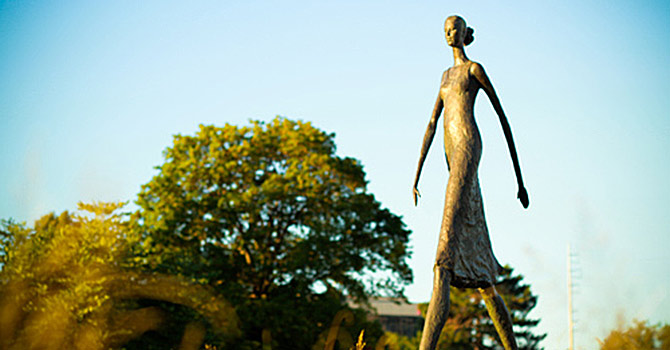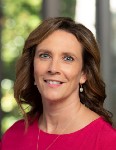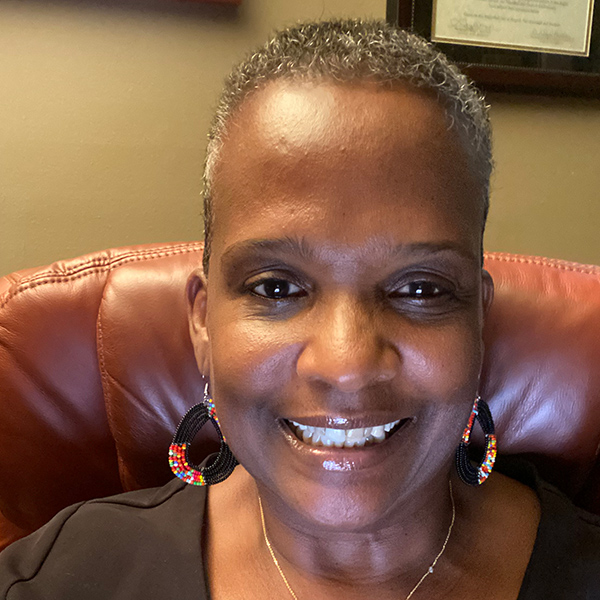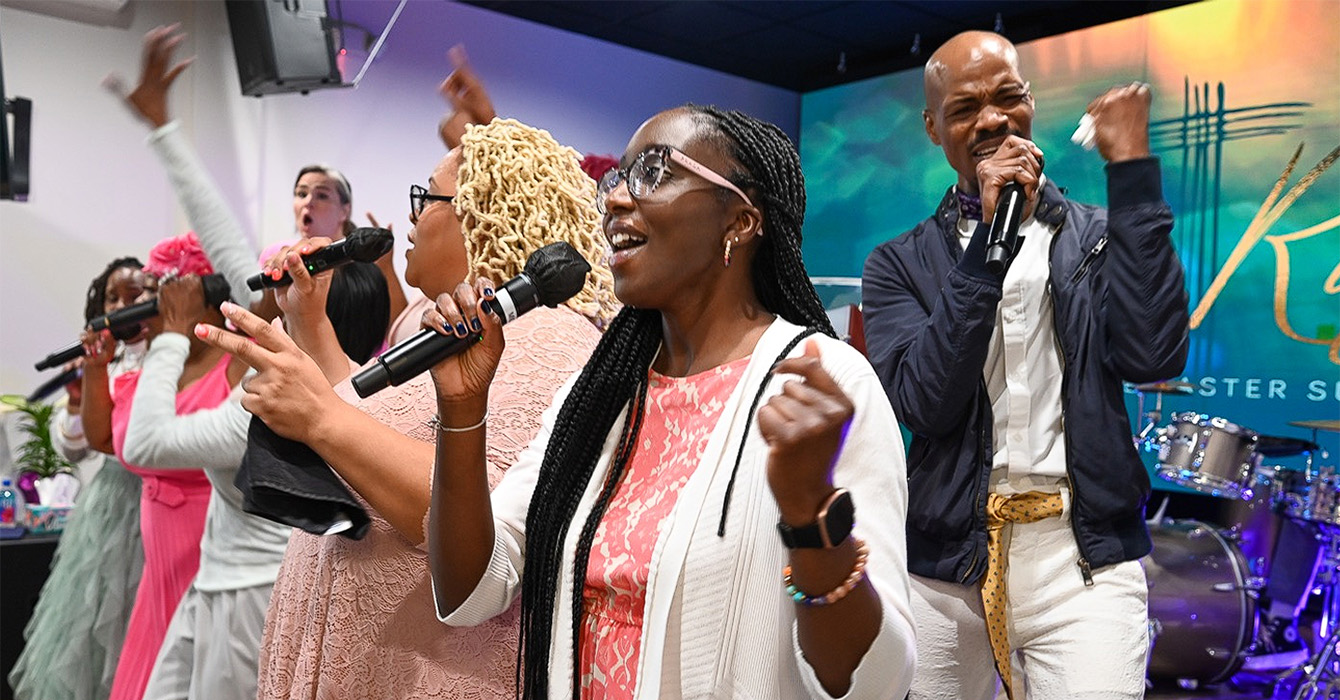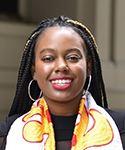Twenty-one years ago, when Maryanne Stevens, RSM, became president of College of St. Mary in Omaha, Nebraska, the school was “on the rocks” -- deeply in debt, with declining enrollment.
But now, at a time when many women’s colleges are struggling and even closing, the school’s enrollment is higher than ever, the endowment is up, and finances are sound.
The turnaround happened, Stevens said, because the college refocused on its mission.
“We asked, ‘Who were we founded to be, and how does that translate into these times?’”
The school had been launched in 1923 primarily to educate women teachers for parochial schools in Nebraska.
“So we looked for what I called niches of women that we could serve,” Stevens said.
By design and by luck, Stevens and her team found new populations who would be drawn to a Catholic women’s college, including single mothers, Nebraska’s growing Latino population and more.
“It really is all response to need more than sitting around thinking up a grand plan,” she said.
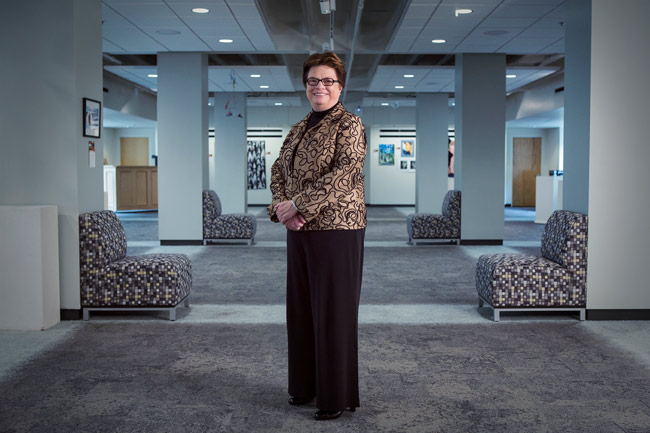
Before becoming president of College of St. Mary, Stevens was a professor of theology and the chair of the theology department at Creighton University in Omaha. A member of the Sisters of Mercy, the college’s founding order, she has a bachelor’s degree in math and sociology from College Misericordia in Dallas, Pennsylvania; a master’s degree in theology from St. Louis University; and a Ph.D. in religion and education from Boston College.
Stevens spoke recently with Faith & Leadership. The following is an edited transcript.
Q: What was the situation at College of St. Mary when you were named president in 1996?
The college was on the rocks. It had about $5 million in debt on an $11 million budget -- $2.5 million on a fitness center they built without knowing how they would pay for it, and the other $2.5 was accumulated operating debt.
I’ll be a past president someday, so I’m not going to speak about past administrations. But I would say that the college had suffered from some of the throes that many small private colleges suffer from. They had a lot of hope, but not a lot of resources.
My metaphor was that we were growing not grass but weeds. We were mowing weeds around the campus. It was tough.
I was on the St. Mary board and was chair of the theology department at Creighton University at the time. I told the board that we should give the college one more chance to be really clear about who and what it is.
And in a result that I was not expecting, they asked me to become the president, and we gradually dug ourselves out of debt.
Some of the college’s success since then was because we focused on our mission. We asked, “Who were we founded to be, and how does that translate into these times?”
We were founded in 1923 as a college for women, to educate teachers primarily for the Catholic schools in the region, but also for public schools.
So we looked for what I called niches of women that we could serve.
The first niche we came up with was single mothers. A young woman from a community two and a half hours north of here was a junior, living in our residence hall. She came to me and said she was pregnant and didn’t know how she was going to finish college if she couldn’t bring her baby back to the dorm.
I said, “Well, let me think about it.”
About the same time, the Chronicle of Higher Education had an article about a women’s college in Pennsylvania that had a house where single mothers and their children could live. So I sent our residential life people out there to find out how they did it.
They came back and said, “There are only two rules: the kids can’t be in class, and they can’t be unaccompanied on the campus.”
And I said, “OK.”
We reopened some old convent space in the main building that wasn’t being used well and used it as a residence hall for single mothers and their children. We started with eight students and became known as friendly to single mothers, whether they lived on the campus or not.
In 2012, we built a free-standing residence hall for single mothers and their children. The students pay the same tuition they would pay without a child, and the child can live and eat here free.
Q: I understand that it received a huge amount of attention nationally.
It did! It got a lot of attention, because it was one of the first in this region, if not in the United States. Many colleges have had family housing for graduate students, but very few, if any, had reached out to single mothers in quite that way.
This fall, 15 percent of our students are single mothers. They don’t all live on campus, but we’ve become known as friendly to and understanding of that population.
Later, we hired a director of single parent success who helps these students. Some are a flat tire away from not being able to get to school and not being able to get to day care or whatever. She connects them with various resources in the community that can assist them.
The second population that we began to reach out to was the growing Latino population in Nebraska. Nebraska would have no population growth if it weren’t for the new immigrants coming in.
Q: They work in the state’s agriculture industry, in the processing houses and so forth?
That’s right. The basis of our economy here is agriculture. So we follow very carefully immigration reform and the DACA decisions that are being made.
When we first enrolled Hispanics, some were American citizens, but some were not. They were undocumented, and there wasn’t DACA at the time. But we found donors to help support them.
Part of our thought process was that we had to grow the enrollment, so who are the new people in town who might be attracted to the college?
For the same reason, we’re beginning to look at the new African populations that are coming into Omaha. We reportedly have the largest South Sudanese population outside the Sudan.
So there are all these pockets of people, most of whom are first-generation college students who will thrive in a smaller environment.
Q: Given the situation at the college when you started, why did you take the job?
Another board member told me, “I think you should do this.”
And I said, “I have a job!”
But I had been arguing that we needed to give it another chance, so I came over that evening and just walked around the campus.
I do believe there was a call that was different from anything I had been conscious of before. I thought, “I really should. This really is something I should do and that I feel called to do.”
That’s why I did it.
I came back the next day, and I said that I wanted to do this right, that the board and the faculty had to run me through all the interviews. But it was a pretty foregone conclusion. It wasn’t exactly an attractive job for anybody.
Q: That was 21 years ago. What was your vision back then?
We had a board meeting in the first year and a half where somebody came in and asked us to “draw your vision.”
I drew a full parking lot. I can’t draw, so I just drew lines, and smudges for cars. Basically, I said that my vision is that we have a full parking lot.
And we do! We just added a hundred more parking places this summer.
Q: That vision was about more than parking.
The vision was that we needed more students, and then, when we were full, we would be asking, “How are we going to expand?”
Today, our residence halls are the fullest they’ve ever been, and we’re asking, “What are we going to do next year?” Our parking lots, even with those hundred new spaces, are still too full some mornings. People park in fire lanes and on the grass.
Q: How’s the college doing financially?
Very good. Our enrollment is up 9 percent this fall. We don’t have any debt, because I won’t build anything or do anything until I know we have the money at least pledged.
We’re in very good financial shape. We have a $19 million endowment, which is too low, but that’s not uncommon in a small private college.
Q: What was it when you started?
$4 million.
I rack this all up to the angels. There’s a lot of God in this. There’s a lot of faith from a lot of people, not just me.
But I really do believe it was a call.
I have a small group of women that I have been friends with for a long time. I told them in the beginning that if it doesn’t work, we’re just going to sell the college’s assets, pay off the debt and put the rest into a foundation for women’s education.
We weren’t sure it would work. But “by little and by little,” it has.
I could have told you how much we spent on copy paper those first three years. I mean, I knew every budget.
Q: You watched it that closely?
I had to, because we were spending more than we had, and I had to cut things.
I cut some programs. At the time, we also had a weekend college, and an evening college where we promised people they could get their degree just going in the evenings.
Within the first five years, I said, “We’ll still have evening classes, but we’re not going to guarantee that you get your degree only in the evenings.” We dropped the weekend college and began to develop some online classes. I cut things that just weren’t working anymore.
Q: How do you explain the college’s success when so many small women’s colleges have closed?
Our largest programs are in health professions, and that makes a big difference. Our largest program is nursing, and the second is occupational therapy. We just started a physician assistant program.
We’ve worked to make those unique. For instance, usually to be a physician assistant, you go four years undergrad and then apply to a PA program. But here, you can do your undergrad in three, and then you’re in until you’re out. If you start with us as a freshman or come in as a young transfer, as long as you meet the progression requirements, you’re guaranteed a seat in our PA program.
We’ve done the same thing with nursing. You can do it in three years if you go in the summers, or you can do it in the traditional four years. And we’ve done the same with occupational therapy.
It’s more affordable, and the students don’t end up with as much debt. We’ve tried to develop those kinds of niches for students.
Q: But so many people think that women don’t want to go to women’s colleges anymore.
Well, they don’t.
They don’t come here because it’s a women’s college. They come here because of the programs.
But then they gain very quickly an appreciation for its being a women’s college.
Also, our property abuts the University of Nebraska at Omaha, and in between, there are all kinds of bars and restaurants and retail. There are lots of young people in this area.
We appeal to a lot of students. The median age of our undergrads is 23. There are a lot of women who come back to school, who stopped or never had the opportunity to go, who see this as a very inviting environment.
Q: How did you get this insight that there were niche populations out there that might be interested in coming to College of St. Mary?
It was an accident! It was an angel, you know? It was a woman from northeast Nebraska who came and said, “I don’t know what I’m going to do if I can’t bring my baby back to the dorm.”
And it was looking at the newspaper and saying, “The Hispanic population is growing. Who’s reaching out to them?”
It really is all response to need more than sitting around thinking up a grand plan.
Q: To what extent does your vision for College of St. Mary flow from theological convictions? How does your vocation as a sister shape your leadership?
I would say that mercy is a response to need. And as a Sister of Mercy, that’s part and parcel of how I have been formed.
I grew up at a time when John Lennon was singing, “Imagine all the people living [life in] peace.” My heroes were people like Dorothy Day and Martin Luther King. Those people, and their rootedness in Christianity, inspired me.
Moses is one of the greatest characters in the Bible. Like, there’s this bush speaking to him that frightens him to death and urges him to go and save his people, and he doesn’t want to go. So those are the touchstones in my life, if you will.
There’s no reason for the College of St. Mary to exist except for our students. They pay our bills; they pay our salaries. Our success has a lot to do with that focus on our students. I’m not saying that every college doesn’t have that, but I do think we have it in a unique way.
Q: What’s the role of risk-taking in your leadership? It must have looked very risky in the beginning.
Well, it was risky. But call can overcome risk.
Sometimes the risk was wondering what donors will think: “What do you mean, this is going to become a college just for single mothers? If that’s the word on the street, will people send their kids here?
“Or if there are a lot of Hispanics?” Nebraska is an extremely parochial state. We were the last state in the union to allow DACA students to get driver’s licenses.
So you ask yourself, “How is this going to go over?”
I certainly had tensions with that, but it hasn’t stopped us from saying, “No, this is the right thing to do.”
Q: To sum up, what’s your philosophy of leadership?
My ideas around leadership have matured significantly over 21 years. When I came, I just had to clean things up. You see things that are wrong and you say, “We’ve got to fix them.”
Now, my philosophy of leadership is to focus on what’s core to your mission and make sure people are well-versed in that so they can choose whether to give their all or else, basically, to go away.
That’s a lot of listening and a lot of culture building, but it’s essential to a successful organization, and to leading a successful organization.

